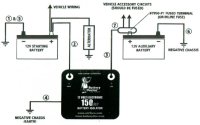Dan Robinson
EF5
With a couple of new recent additions to my car's equipment circuit, it's now drawing enough current to drain the stock battery quickly if it's left on without the engine running. So, it's time to move the circuit off of the stock battery and onto its own deep-cycle battery, with an isolator to allow the alternator to charge it.
I'm hoping several chasers have done this before and have some insight or recommendations. My issue is that I have no room for another battery under the hood, it will have to go into the passenger compartment or in the trunk. As such, it will have to be sealed, obviously.
I've done some homework and it appears the setup is very simple - just a new battery and the isolator - but I'd like the deep-cycle battery to be robust enough to keep everything running for a couple of hours minimum if needed (to keep timelapses going on the dashcams, for instance).
I'm hoping several chasers have done this before and have some insight or recommendations. My issue is that I have no room for another battery under the hood, it will have to go into the passenger compartment or in the trunk. As such, it will have to be sealed, obviously.
I've done some homework and it appears the setup is very simple - just a new battery and the isolator - but I'd like the deep-cycle battery to be robust enough to keep everything running for a couple of hours minimum if needed (to keep timelapses going on the dashcams, for instance).

